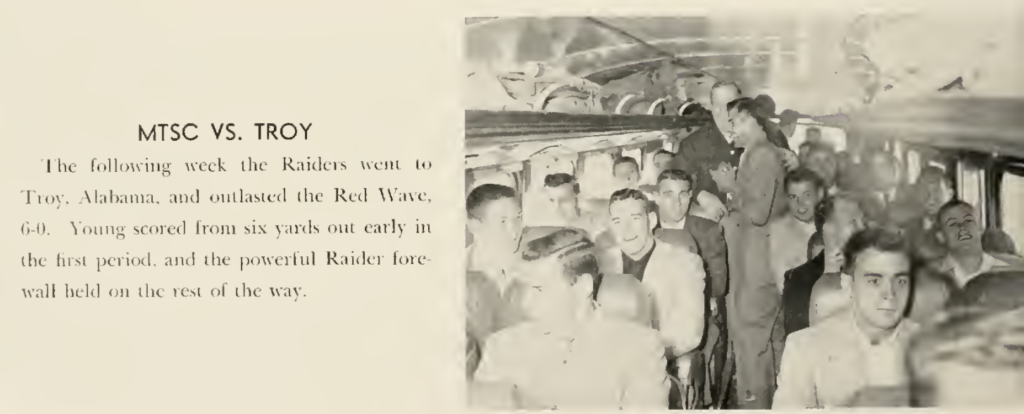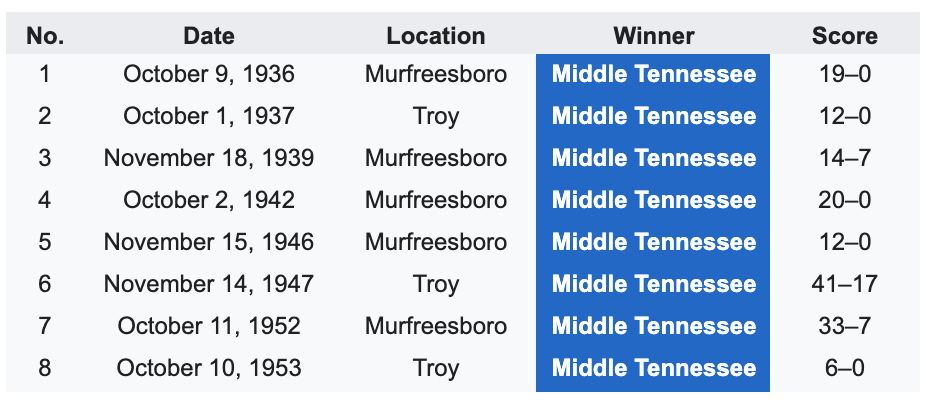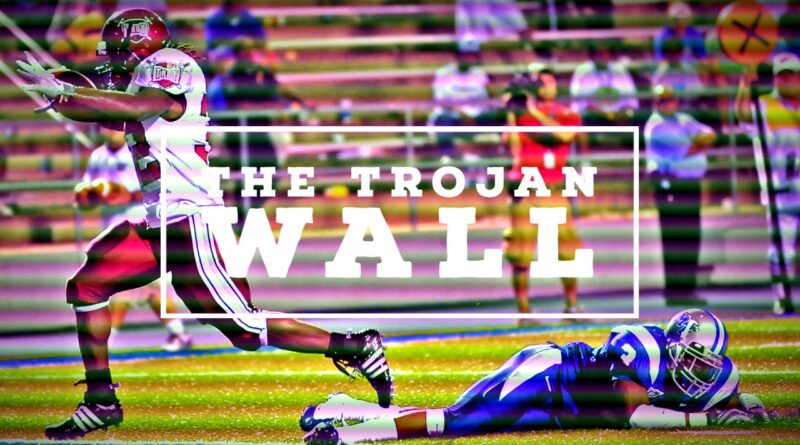College Football Mythology: the Legend of the Palladium
“See what fine prizes he is taking home from Troy”
The Odyssey, Book X
Every mention of the Palladium trophy comes with a reference to its ancient namesake. Supposedly it was an icon of the goddess Athena that fell from the heavens as an answer to prayer from the man who founded Troy.
According to legend, as long as it was in Troy the city was under Athena’s protection. During the Trojan War, Odysseus, Raider of Cities, stole the Palladium from the city’s mighty walls. In spirit, it’s fun lore for a rivalry.
The visual similarity isn’t the last place the correlations meet. It’s not just a fun tie to the Greek heritage of both mascots, the statue’s story is also full of drama.

In the late 30s, the wild early years of college football, the two teams set up a series that saw Troy playing in Murfreesboro three out of the first four years. On October 9, 1936 Middle Tennessee whipped Troy State 19-0.
Spoiler alert: Troy didn’t beat Middle Tennessee until 1999. In fact, the Trojans/Red Wave/Teachers only scored a single touchdown in the first decade it played the Blue Raiders/Normalites/Teachers. From 1936-1953, Troy scored a total of 31 points; out of eight games the Red Wave broke the goal line in three.
After the war, Troy and MTSU played a pair of home-and-homes. The first game was a blowout: Troy scored a series-high 17 points but gave up a series-high 41. For those of you doing the math at home, here’s what that table looks like:

In 1952, Middle Tennessee joined the young Ohio Valley Conference, and with that being the biggest correlation to the series’ first hiatus, it’s safe to say the teams split up.
They didn’t talk for another 45 years.
In that time, MTSU and Troy followed their own roads to Division I. The Blue Raiders made the jump to I-A in 1999, starting fresh with a new coach and bringing the Trojans along for the ride—as the Homecoming opponent.



For the first time in 63 years, Troy got its first win in Murfreesboro. It was part of an incredible 1999 season that saw a 10-1 season fall apart in the second round of the playoffs. Meanwhile, MTSU limped to a 3-8 record.
The series took Y2K off, before coming right back to Floyd Stadium on September 9, 2001. It was a year of firsts—the Trojans’ first year at I-A and the Sun Belt Inaugural Football Season. The series returned to form with a massive Blue Raider win, 54-17.
Rinse and repeat. The teams took a year off before meeting up at MTSU. Incidentally, a familiar face joined the Blue Raider program, and in 2003 the Blue Raiders won it 27-20. Then came another milestone year for Troy, and the physical embodiment of bragging rights.



In 2003, clearly not content with their team’s domination in the series and not quite understanding the context of the original story, MTSU grads got with both SGAs to come up with a rivalry trophy. (Sound familiar?)
The groups commissioned an artist in Massachusetts to sculpt a replica of the Athenean Palladium from basswood, later adding gold leaf to the helmet, spear and shield. Eventually the trophy included a massive base with a poem and list of winners in the series.
It was revealed at the 2004 game, which also went by the names “World’s Largest Outdoor Toga Party,” a spoof of the Florida-Georgia rivalry, and “Fort Rucker Appreciation Day.” (With this week’s game being another Military Appreciation game, MTSU ties ULM and FAU as three-time opponents.)
Troy kept the prize at home, winning the trophy for the first time 37-17.
The next year, the Raiders followed the namesake story, stealing back the Palladium in a 17-7 win. Up 11-2, it would take a miracle to change Troy’s standing in the series.
If you haven’t heard of the Miracle in Murfreesboro, here’s the gist. Middle Tennessee scored with about 11 minutes left in the game to go up 20-7.
Nine minutes later, Omar Haugabook found Smokey Hampton to get Troy back into the game. The Trojans recovered the onside kick, drove down the field and scored the game-winning touchdown.
The win forced a split title between the two teams, but the head-to-head win put Troy in the New Orleans Bowl. Still, for first year coach RIck Stockstill, a conference title is an incredible way to start your tenure.
Watch the entire fourth quarter over at TroyTrojans.com.



The Miracle tied the modern series at 3-3. The back-and-forth was so close that ESPN called it the No. 5 best non-BCS rivalry in America in 2008.
That comeback also fueled a change in momentum across the series. Troy won the next five games, scoring at least 31 and giving up an average of 16 points each game. The series turned from 11-2 to 11-8.
The streak also tied into Troy’s five-straight conference titles. The Trojans’ run from 2006-2010 isn’t the highest point in program history, but it’s the longest stretch of continued success Troy has ever seen.
Troy’s dominance correlated directly with the Palladium’s time in the Wiregrass.
Then the Blue Raiders took their statue and went home.


With nine minutes left in the game, Troy took a 21-16 lead. On the next drive, Brynden Trawick intercepted the ball, seemingly sealing Troy’s sixth-straight win.
Troy drove into MTSU territory when the Blue Raiders forced a turnover of their own—a pick-six. Middle Tennessee nailed the two-point conversion, taking a 24-21 lead. It was the Raiders’ first win over Troy in seven years.
The next year, Middle Tennessee left the Sun Belt and joined Conference USA. The Raiders have yet to bring a title to Murfreesboro since 2006, but Coach Stockstill added five bowl appearances and one win in that time.
The insanity of 2020 brought Troy and Middle Tennessee back together not once but twice. It’s just the third regular season rematch in the modern era (New Mexico State/Liberty, 2018 and 2019).
This week Troy is looking to bounce back from a close loss, while MTSU is trying to find some positive in a down season.
Whatever happens we won’t forget how the first matchup ended anytime soon.


Ahhhh. I do remember this. I was the guy, who met with the SGA presidents, who helped make the Palladium a reality.
I got with fans of both schools’ online sports forums and pitched the idea of a rivalry game. When the mythological connection was pitched and the concept of “Palladium” was realized, I selected the image of Athena to be used for the trophy and shared it with all the fans for approval. And since the real Palladium was made from wood, it made sense to all of us that ours should too, so I hired Marcia Berkall, owner of Whittlin and Wood from Maine, to hand carve the statue from a photo I provided.
I remember the week the first Palladium game was to be played. After a few days allowing MTSU’s SGA to promote Palladium in Murfreesboro, I took the statue and drove to Birmingham where I passed her off to a Troy fan, whose name and can’t remember now, so he could take it to Troy and have it promoted all the way up to GameDay since Troy was going to be the host at what was then called Movie Gallery Veterans Stadium.
Troy won that game, and I was there freezing my tail off in a toga and summer wear underneath. But it was still fun. Thanks for rekindling one of my cherished memories.
I still keep tabs on both Troy and MTSU, but I am no where near the enthusiast I once was. I packed my life up in 2008 and moved to Colorado, finished school, and then moved to Utah in 2012 and been here ever since.
I still look back on Palladium with sweet nostalgia. So again I say thank you.
Correction: The first Palladium game was 2003 because I remember Andy McCollum’s disappointed demeanor at the trophy after MTSU won. McCollum was fired in the offseason and Palladium got overhauled by a Murfreesboro wood carver that expanded its size and appearance to what it looks like today.
Then came 2004, which was the experience I mentioned in my previous comment.